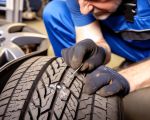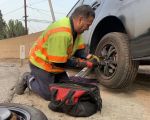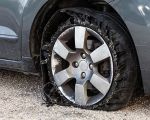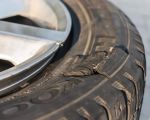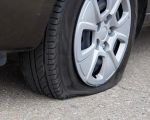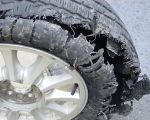How to Check if My Flat Tire Can Be Repaired: A Comprehensive Guide
If you’ve ever found yourself with a flat tire, you know how frustrating it can be. Whether you’re stuck in a parking lot or on the side of the road, it’s one of those problems that can stop you in your tracks. The question often arises: can my flat tire be repaired, or do I need to replace it? I’ve been in this situation a few times, and each time, I learned something new about tire repair. In this article, I’ll share my experience and guide you through the steps to determine whether your flat tire is repairable or needs replacing, as well as what to do next.

MR. TIRE INC.
2078 New York Ave, Huntington Station, NY 11746, USA
1. Understanding the Basics of Tire Repair
Before diving into the specifics of checking if your tire can be repaired, it’s important to understand the basics of tire damage. Over the years, I’ve learned that not all flat tires are the same, and some are definitely easier to fix than others. Some flats can be repaired quickly with a simple patch, while others may need a full replacement. The condition of the tire and the nature of the damage will determine if it’s repairable. But how do you tell the difference? That’s what I’m going to help you figure out.

MR. TIRE INC.
2078 New York Ave, Huntington Station, NY 11746, USA
1.1 Types of Tire Damage
When I first encountered a flat tire, I wasn’t sure what kind of damage had occurred. There are several common types of tire damage, each requiring a different level of repair. Here are the most common ones I’ve encountered:
- Small Punctures: These are usually caused by nails or screws. If the puncture is in the tread area and the object is still lodged in the tire, it’s often repairable.
- Sidewall Damage: Damage to the sidewall of the tire is usually a no-go for repair. I once had a tire with a deep gash on the sidewall, and I learned quickly that these kinds of damages are too dangerous to fix.
- Blowouts: A blowout occurs when the tire completely loses air, often due to a manufacturing defect, under-inflation, or a sharp object. These types of tires typically can’t be repaired and need to be replaced.
- Flat from a Valve Stem: Sometimes, the valve stem can become damaged, causing air to leak. In my case, the valve stem was the culprit, and it was a quick fix with a simple replacement of the valve.
1.2 When Can a Flat Tire Be Repaired?
In my experience, a flat tire can usually be repaired if the damage is limited to the tread area and is smaller than 1/4 inch in diameter. If the puncture is on the sidewall or shoulder, it's not advisable to repair it. Another key factor is how long the tire has been flat. If it’s been sitting deflated for an extended period, the tire may have suffered further damage, and it could be unsafe to repair. I’ve also learned that if the tire has been driven on while flat, the internal structure may be compromised, making repair impossible.
2. How to Inspect the Tire Yourself
Once you’ve identified that you have a flat tire, it’s time to inspect the damage. I’ve been in situations where I wasn’t sure if the damage was repairable, but a quick inspection helped me make that call. Here’s how I check the damage and assess whether the tire can be repaired:
2.1 Visual Inspection of the Tread
The first step I always take is to visually inspect the tread for any visible punctures. If there’s a nail, screw, or other object lodged in the tire, there’s a good chance it can be repaired. In my case, I’ve often been able to spot the object easily. If the puncture is small and located in the tread area (away from the sidewall), it’s usually repairable. Be sure to check the area around the puncture as well for any signs of cuts or damage.
2.2 Check the Sidewall and Shoulder
The sidewall and shoulder are the most important areas to check when determining if the tire can be repaired. I’ve learned that even small tears or cuts in these areas can make the tire unsafe. The sidewall is under constant pressure when the car is moving, so if it’s damaged, it can lead to further tire failure. If you see a puncture or crack on the sidewall, it’s time to replace the tire. In my experience, this is often the most frustrating type of damage because sidewall repairs are not possible.
2.3 Inspect for Bulges or Cracks
Another important thing to look for is bulges or cracks. I once had a tire with a small bulge, and after consulting a professional, I learned that it was due to internal tire damage. Bulges can cause a blowout, especially at high speeds, so it’s essential to get rid of them as soon as you notice them. Similarly, deep cracks along the tire’s surface usually indicate significant structural damage. In these cases, even if the puncture is repairable, the tire should be replaced for safety reasons.
3. Repairing the Tire: DIY vs. Professional Help
Once I’ve assessed the damage, the next step is deciding whether to repair it myself or call a professional. I’ve tried both options, and there are times when I’ve been able to fix it myself, and other times when professional help is the way to go. Here's what I’ve learned about tire repairs:
3.1 DIY Tire Repair Kits
If the puncture is small and in the tread area, a DIY tire repair kit can be a lifesaver. These kits usually come with a rubber plug, adhesive, and tools to insert the plug into the tire. I used one of these kits once when I had a nail in my tire, and it worked well enough to get me to a shop for a more permanent fix. However, DIY repairs are usually temporary solutions, and I always recommend getting a professional repair afterward to ensure the tire is safe for long-term use.
3.2 Professional Tire Repair Services
In my experience, calling a professional is often the best option, especially if you’re unsure about the severity of the damage. Professional tire repair services can inspect your tire thoroughly and fix it properly. They’ll patch or plug the tire from the inside, ensuring it’s sealed correctly. I’ve used tire repair shops multiple times, and I’ve always appreciated their expertise and attention to detail. For most cases, they can repair the tire for much less than the cost of a replacement, which is a big win in my book.
4. When to Replace the Tire
There are times when repair is simply not an option. I’ve learned that if the damage is too extensive, or if the tire has been driven on while flat, replacement is the safest choice. Here’s when you should consider replacing your tire:
4.1 When the Damage is on the Sidewall
As I mentioned earlier, sidewall damage is a major red flag. The sidewall is crucial to the structural integrity of the tire, and once it’s compromised, the tire can’t be safely repaired. I’ve had to replace tires several times because of sidewall damage, and I’ve learned to act quickly. A simple repair will not be enough, and you’ll be better off replacing the tire altogether.
4.2 When the Tire Has Been Driven on While Flat
If you’ve driven on a flat tire for an extended period, the internal structure of the tire is likely compromised. I once had a tire go flat, and instead of pulling over immediately, I tried to drive on it for a few more miles. By the time I stopped, the tire was beyond repair, and I had to replace it. Driving on a flat tire can damage the sidewalls and make it impossible to repair.
4.3 Extensive Punctures or Multiple Issues
In some cases, a tire may have multiple punctures, or the damage could be extensive enough that a repair simply wouldn’t be effective. I’ve seen cases where a tire had multiple small punctures near each other, and after consulting a professional, I was advised to replace the tire. Trying to patch multiple areas of a tire can compromise its integrity, making it unsafe to drive on.
5. Conclusion: Knowing When to Repair and When to Replace Your Tire
Figuring out whether your flat tire can be repaired is an essential skill for any car owner. Whether you’re dealing with a simple puncture, sidewall damage, or something more serious, understanding the type of damage and knowing when to call in a professional can save you time and money. Over the years, I’ve learned that tire maintenance, regular inspections, and knowing when to act can help keep you safe on the road. The next time you’re faced with a flat tire, use these steps to assess the damage, decide if a repair is possible, and take the necessary steps to get your car back on the road quickly and safely.














